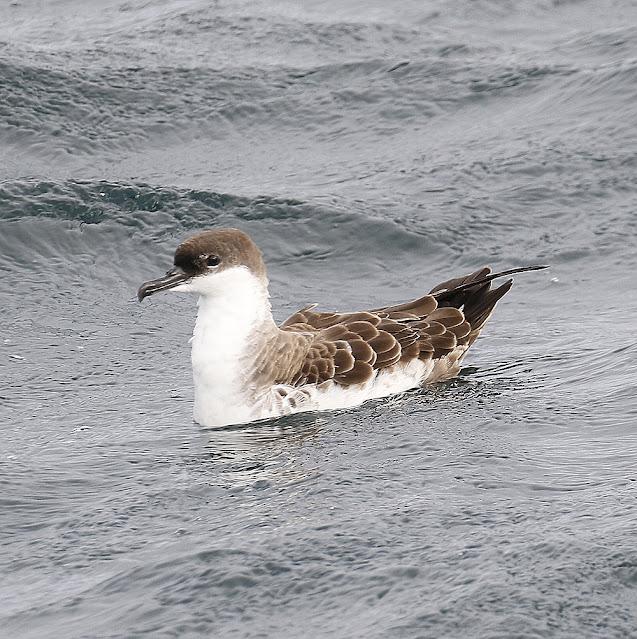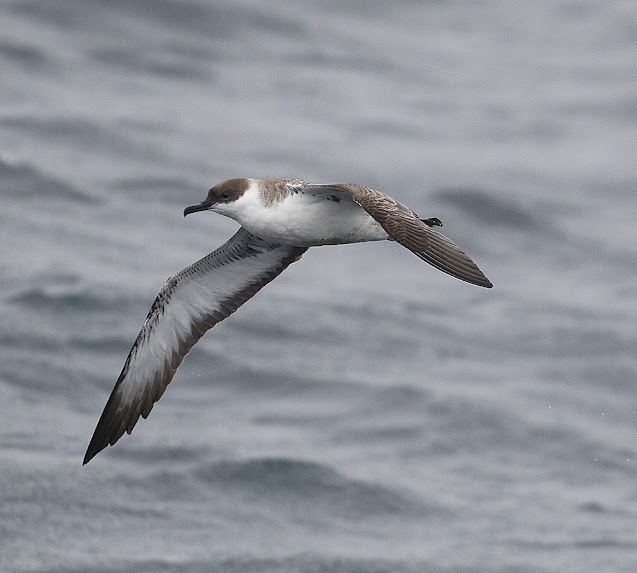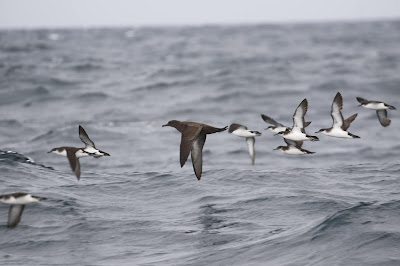The pelagic today was an early one, leaving Hugh Town quayside at 8am and we would be out at sea for seven hours. The prospects looked bleak and unappealing in the current weather conditions but there was nothing that could be done to change the weather so we would just have to get on and make the best of it.
I had donned everything that I considered would keep me warm and waterproof out at sea and trudged along a wet and deserted Church Street, passing through Hugh Town and made my way towards the quayside past the well known pub, The Mermaid, ever popular with tourists and birders alike.
The quayside was devoid of life and I was the only person venturing out onto its unwelcoming wet concrete promenade. I settled on one of the bench seats under the sheltering canopy that ran the length of the buildings on one side of the quay to await the arrival of Andy, making his way down from The Garrison. I looked out onto the grey sea in the harbour, a dreary prospect in the dull light of such a damp morning and looking so very different from yesterday. The air was mild but had that constituency of dampness and slight mistiness about it that is almost oppressive and without fail lowers one's spirits.
Morosely, I sat, chin sunk into my clothing and waited for Andy whilst watching two bedraggled Rock Pipits and some equally dishevelled House Sparrows taking advantage of the currently deserted quayside to hunt for food amongst the cracks in the concrete or around the waste bins but they soon departed. Sandwich Terns, in small groups, their grating calls alerting me to their presence, came into the harbour, flying high above the moored craft, with even their white plumage dulled by the oppressive conditions and grey sky. They swept onwards passing over the town, probably making a shortcut and heading for Porthcressa Beach, that lay,not that far, on the opposite side of the island.
Andy arrived and we sat and waited for Bob and Joe's arrival and then we all trooped onto the MV Sapphire after Joe had wiped down the benches. I say all of us but there were only about half the number of birders to yesterday so there was plenty of room on the boat which was just as well as we all huddled by the canopy next to the wheelhouse to shelter from the elements.
Today we headed for the same general area as before, but only some three miles beyond St Martin's this time, cleaving through a grey sea, the visibility very much reduced and as before, once beyond St Martin's, our regular companions, Gannets, Fulmars and large gulls formed up in our wake and circled the boat as we headed out into what was, today, an unwelcoming and forbidding Atlantic There was little sign of the tuna this morning just the occasional churning of water into a white disturbance but nothing to compare to the previous days. Consequently we had to work a little harder to find the birds.
 |
| Great Shearwater |
We also encountered a good number of Sooty Shearwaters, often to be found in amongst a raft of Manx Shearwaters, and for me, the most elegant of the shearwaters, their angular profile in flight almost albatross like but in miniature.
They were using the wind to good effect and it was only when one came reasonably close that you realised just how fast they were moving across the sea. A uniform dark brown all over, the silvery white underwings were the only noticeable feature of their plumage and even this was subdued in the bad light, as they tilted over to one side to fly in the lee of a wave. A few, always singly, were settled on the sea but as soon as we were anywhere near them, took off with pattering feet, their progress marked by splashes as their webbed feet galloped across the sea's surface
After the excitement of large shearwater action we commenced chumming for petrels, sooner rather than later, stopping the Sapphire's engines and floating or should I say rolling endlessly on the turbulent sea swell. As per usual it took some time to attract any storm petrels but finally European Storm Petrel's began to arrive steadily, one, sometimes two together, flickering indistinctly over the waves made into miniature mountains and valleys of grey by the wind, the petrels tip toeing down the sloping, sliding, shape shifting sides of the waves, their tiny dark wings held aloft keeping them just elevated enough above the sea's surface to delicately pick off food items in the fish oil slick. Their flying skills are immense as they swoop and tack on the wind, using the wave troughs to shelter from gusts, then cresting a white wave top only to slip, flutter and glide down the other side like some slalom skier, before stopping dead to patter on the water with up stretched wings and dangling webbed feet as if marking time, before shooting off, delicate as butterflies on yet another divergent course across and between the heaving might of the ocean.
 |
| Sooty Shearwater with Manx Shearwaters |
After the excitement of large shearwater action we commenced chumming for petrels, sooner rather than later, stopping the Sapphire's engines and floating or should I say rolling endlessly on the turbulent sea swell. As per usual it took some time to attract any storm petrels but finally European Storm Petrel's began to arrive steadily, one, sometimes two together, flickering indistinctly over the waves made into miniature mountains and valleys of grey by the wind, the petrels tip toeing down the sloping, sliding, shape shifting sides of the waves, their tiny dark wings held aloft keeping them just elevated enough above the sea's surface to delicately pick off food items in the fish oil slick. Their flying skills are immense as they swoop and tack on the wind, using the wave troughs to shelter from gusts, then cresting a white wave top only to slip, flutter and glide down the other side like some slalom skier, before stopping dead to patter on the water with up stretched wings and dangling webbed feet as if marking time, before shooting off, delicate as butterflies on yet another divergent course across and between the heaving might of the ocean.
 |
| The pristine state of its plumage and no wing moult would indicate that this Storm Petrel is probably a juvenile |
 |
| This Storm Petrel is presumably an adult as it is in heavy wing moult |
The longed for Wilson's Storm Petrel finally arrived, suddenly and thrillingly out of the gloom, close to the Sapphire, flying past the port side and passing round behind the back of the boat. It was very close to the boat for a petrel but the heaving waves and the constant random movement of the Sapphire disoriented me, so any photo I got was horribly blurred but Andy did much better. In fact he did brilliantly considering the conditions and got a couple of sensational images of it as it passed by and he has been generous enough to allow me to use them and they now grace this blog. What a fabulous creature the Wilson's Storm Petrel is and in Andy's images you can clearly see the diagnostic projecting of its feet beyond the tail and even the yellow webs of its feet, another diagnostic feature of Wilson's Storm Petrel.
 |
| Wilson's Petrel c Andy Last |
The weather began to worsen, the visibility dropped and the light became murkier and a fine rain began to gently fall. Jim took up position at the back of the Sapphire and began casting bread in the wake as Joe slowly steered the Sapphire over the sea. The plan was to keep doing this to attract the inevitable horde of gulls and Gannets which it was hoped would in turn attract rarer seabirds into the wake.
The hoped for Sabine's never showed up but two Arctic Skuas, a light morph and a dark morph came to investigate the throng of gulls as did a couple of Great Skuas and even an immature Mediterranean Gull came in briefly. Our wake was being constantly followed and criss crossed by the black fluttering shapes of European Storm Petrels as they trailed us, often ten at a time, always staying a discrete distance beyond the gulls and Gannets which were virtually hovering over the Sapphire.
 |
| Mediterranean Gull |
They are truly impressive birds, as their powerful solid bodies were carried above me on enormous outspread wings. Seen so close in such situations you become all too aware of their size and majestic presence. That cold blue eye seems to look right through you as they pass at just above head height.
 |
| Northern Gannet |
 |
| Higgo |
 |
| Balearic Shearwater |
Anyway it was a good bird to find and added to the sense of achievement in what was proving to be quite a good day's birding.
Juvenile Kittiwakes can look very much like juvenile Sabine's Gulls from a distance, especially in poor visibility but try as we might we could not turn one into the real thing - smart as the Kittiwakes were in their black, white and grey plumage. Fulmars showed a great interest in the fish oil slick presumably because they too have highly developed olfactory glands that allow them to smell the oil from great distances and they were an almost permanent presence around the Sapphire while we were 'chumming'
 |
Juvenile Kittiwake
|
The gulls continued to follow us and one immature Herring Gull in particular followed us very closely and even perched on the hind rail of the Sapphire, using its wings to balance on the slippery metal as it was constantly buffeted by the wind. It was very distinctive as its brown mottled juvenile feathers were considerably darker than usual and it flew with a curious stiff necked posture so that its head was held more vertically than usual. It accompanied us for some distance and I grew rather fond of it.
The weather continued to worsen until it was raining continuously and the conditions became hopeless for any further birding. Bob, to our unspoken relief and agreement, called it a day an hour early and we set a course for Hugh Town. My so called waterproof outer layer was soaking and no longer waterproof. I was cold and chilled and sat on a bench, bent low with my back to the wind and rain protecting my optics and camera. It was singularly unpleasant and a relief to get back onto land and into shelter.
There was only one thing that would rectify matters and that was to get into a warm environment, find some food and pour hot liquid into my chilled frame, so it was a no brainer to make a beeline for the estimable and ever popular Kavorna Café and Bistro where we each had a huge pasty, a hot coffee and, as a treat, a slice of very nice carrot cake. Feeling a whole lot better about life but still sodden and very wet on my part, I made my way back to Westford House to remove all my wet clothing and have a hot shower. Bliss!
I hung the various sodden items of clothing from every possible hook in my room and in the bathroom and slowly they dried out. The wetter items were given some assistance in the drying process by the dexterous use of a hair dryer I found in one of the drawers!
So here I was enjoying a traditional wet Bank Holiday Sunday. It was an absolute classic. I called Andy and told him I was intent on staying put in my room as I was tired and wet. Andy decided to do some birding locally so we agreed to meet at the Kavorna Café for a coffee and cake at 9.30 tomorrow.
Despite the depressing weather conditions I considered I had a really good day, well who wouldn't having seen a Wilson's Storm Petrel, and in excess of thirty each of Great and Sooty Shearwaters.
This is what we saw on this pelagic
Great Sheawater 40+
Sooty Shearwater 30+
Balearic Shearwater 1
Manx Shearwater 2000+
European Storm Petrel 60+
Wilson's Storm Petrel 1
Great Skua 8
Arctic Skua 2
Mediterranean Gull 1
Black headed Gull 1
Sandwich Tern 9
Arctic Tern 1
Common Dolphin 6
Atlantic Blue finned Tuna 15+
Ocean Sunfish 2
Grey Seal 4
Also seen but not counted
Great Black backed Gull
Lesser Black backed Gull
Herring Gull
Kittiwake
Fulmar Petrel
Northern Gannet
European Shag








































No comments:
Post a Comment